|
|
Not to be out-done by my old-country brethren and sisterren, I bring you the obligatory short post that shows I still have one or two tricks up mein sleeve. Although not so much in the German way. The sausage is weak with this one.
…Yeah, that’s what I mean.
Anywho, I love my Crock Pot. Maybe a little too frequently much. Generally I load some foodstuff into it over the weekend and let it cook such that I have delicious morsels to pick apart during the week. This weekend was no exception:
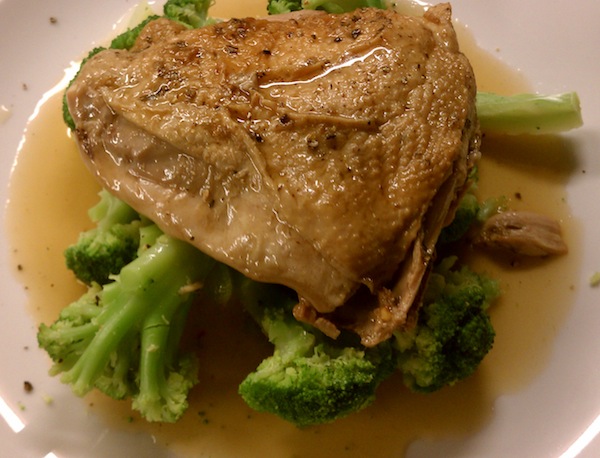 There's nothing like a great thigh. The title speaks for itself.
The great part is it’s dead simple.
- Procure chicken bits, preferrably legs, thighs
- Legs and thighs hold up to this style of cooking; the breast tends to just flake apart into unappetizing chicken flakes
- Pat dry with paper towels
- Season with salt, pepper, and/or your choice of seasonings
- I prefer just salt and pepper, it allows you to change the flavor of the finished product later
- Sear in a pan, preferrably cast iron
- Dump in Crock Pot
- Add flavorful cooking liquid
- Usually I just use chicken broth or water
- In this case, I had a Dogfish Head Namaste along with some store-bought boxed chicken stock
- Set Crock Pot for 4+ hours
- Generally I do this overnight
- Have a bit of a faff during the cooking
- Do with the results as you please
I end up packaging it up in the fridge for use throughout the week; lunches, dinners, midnight snacks, the list goes on. But there’s no stopping you from preparing this in the morning, heading off to work, then returning to a meal basically prepared for you over the day with no tending or worries.
Ja, wir kochen weiter auf Deutsch! If you haven’t already mastered the fine art of cooking Bratwurst in beer, you may want to brush up on that. Of course, perhaps you already have that skill down to the point that you could do it in your sleep except for the fact that you can’t sleep because you’re plagued by the uncertainty of what to serve alongside such a fine Bratwurst. Perhaps you’re a vegetarian and seek a non-meat alternative oriented toward both the bourgeois and fine palates. Or perhaps you’re curious about what sorts of vegetables German-speaking people liked to eat in the year 1901. Well fear not, for the answer to all of those questions and more begins right here, after the end of this sentence which introduces recipe number 697 from L. Kurth’s Illustriertes Kochbuch: Junge Mohrrüben.

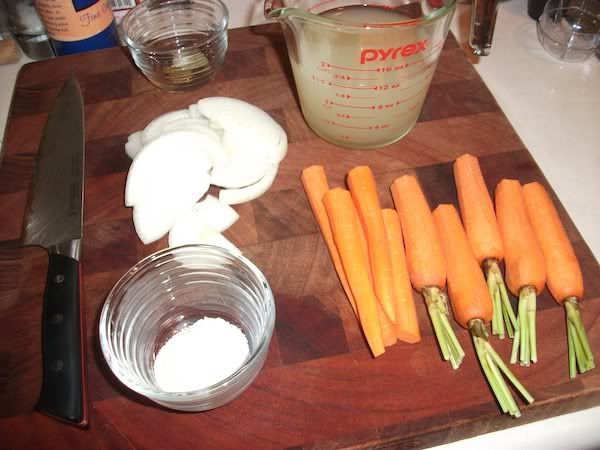
Prep items for the carrots join the previous assembly of items for the Brats. As per Kurth’s instructions, “man kann, um ihnen [die Mohrrüben] ein zierliches Aussehen zu geben, eine ganz kleine Spitze von dem grünen Kraut stehen lassen.”
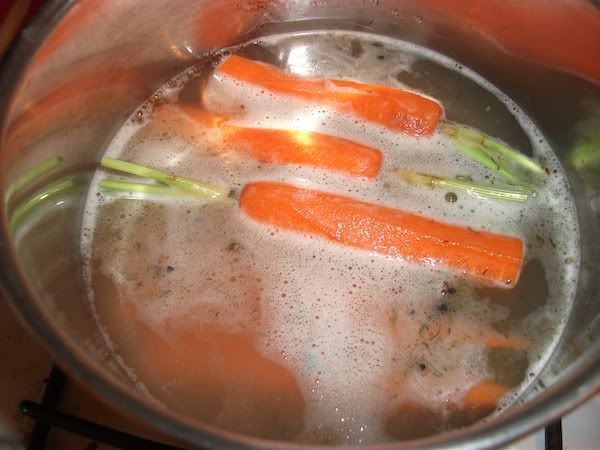
[Man] kocht sie mit Bouillon, einem Stück Zucker, Butter und Salz rasch weich…
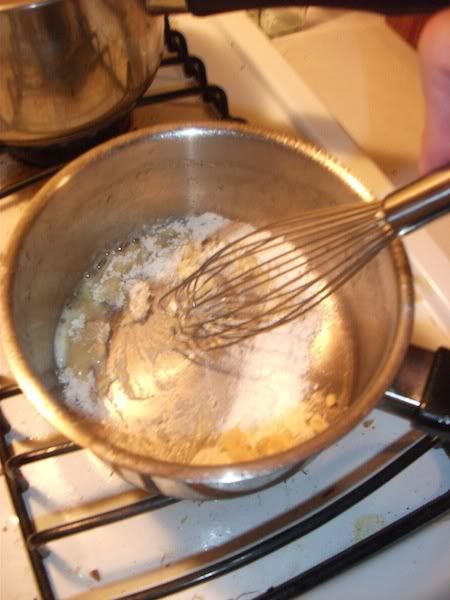
… schwitzt etwas Mehl in Butter…
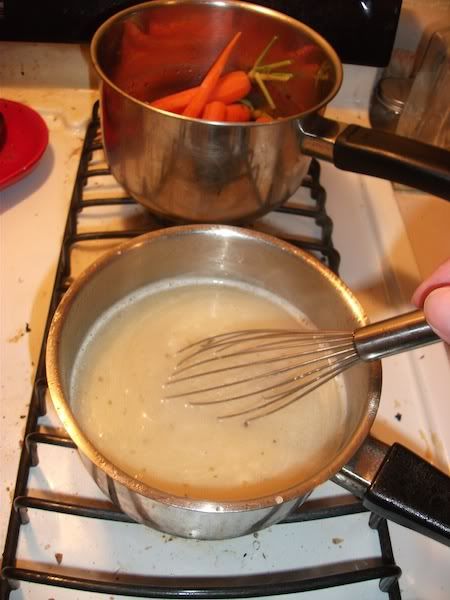
… rührt es mit der Mohrrübenbrühe klar, kocht davon eine seimige Sauce…
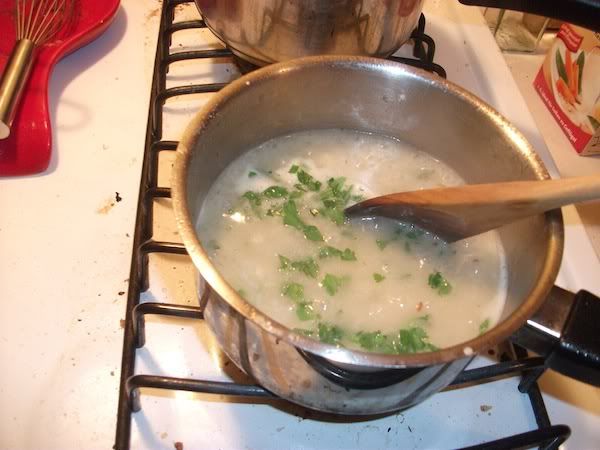
… mischt diese mit gehackter Petersilie…
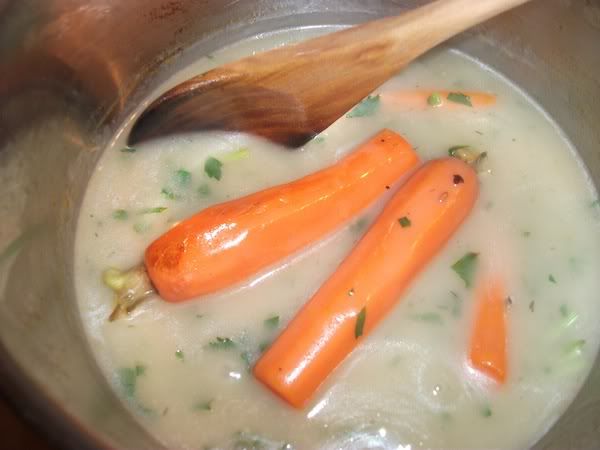
… und schwenkt sie mit den Mohrrüben durch.
I have to say, this recipe is so incredibly old-school German that after one taste I immediately began to doubt the fact that *I* had just cooked these carrots, since it seemed much more likely that my Oma had somehow returned from the grave and prepared this dish herself.
And so we come to the final result:
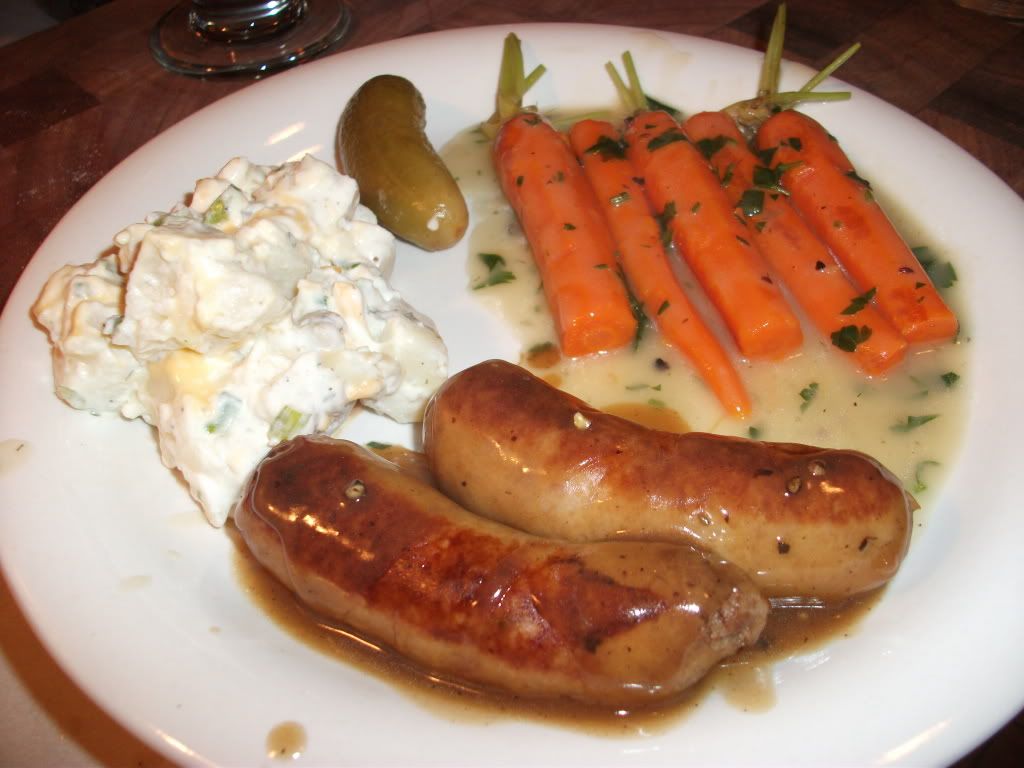
Here I opted to serve the brats and carrots together, along with a pickle and some potato salad. Kurth recommends serving the Brats with either roasted, boiled or mashed potatoes, and I see the merit in this–next time I would go with that option as well, since the gravy that gets made with the brats would lend itself better to a simpler side.
As for the carrots, Kurth recommends either an omelet or fried egg as an accompaniment, or alternatively says that they can serve as a side with any of the same things that the peas can. This required some work to discover where exactly the pea recipe was located in the book, but once it was found, it quickly became clear that peas and carrots apparently go with anything. Whether you’re serving pork, lamb, chicken, sausage (hence combining the carrots and brats on the same plate here), french toast, milk pudding (yes, you read those last two correctly) or smoked eel, you just can’t go wrong with peas or carrots. Or at least you can’t go wrong if you’re serving middle-class Germans from two turns of the century ago. So now if zombie Kaiser Wilhelm ever shows up at your door one night, you’ll be prepared to offer him something much more pleasant than your brains for supper!
This summer I had the exciting opportunity to keep being employed for at least two months longer by teaching the second semester of a two-part course: “German for Graduate Reading Knowledge.” The point is to teach graduate students who might have to read texts in German how to do that without having to go to all the trouble of actually teaching them German. Of course one of the many difficulties in this process is encountered in Fraktur, that extra ornate, old-style German print that the “Old English” fonts in Microsoft Word try to kind of imitate the look of in a generally more legible way. Since the words themselves aren’t any different, the main difficulty in reading Fraktur is simply recognizing the letters. So to test if my students actually were both recognizing letters and understanding sentences correctly, I assigned them the task of translating a pair of texts from the 1901 edition of L. Kurth’s Illustriertes Kochbuch. For extra credit, they were given the opportunity to demonstrate their understanding of the recipes by cooking them and documenting the process (or alternatively to press someone else into service and direct the (un)fortunate accomplice in the preparation of the food).
The two texts for this assignment were #553 “Bratwurst in Bier gekocht” and #697 “Junge Mohrrüben.” So without further ado, here are my results for the first of those.


Prep for #553. The secret ingredient is having one beer to cook with and another just to drink.

“Man legt die Bratwurst, damit sie nicht platzt, in kochendes Wasser…
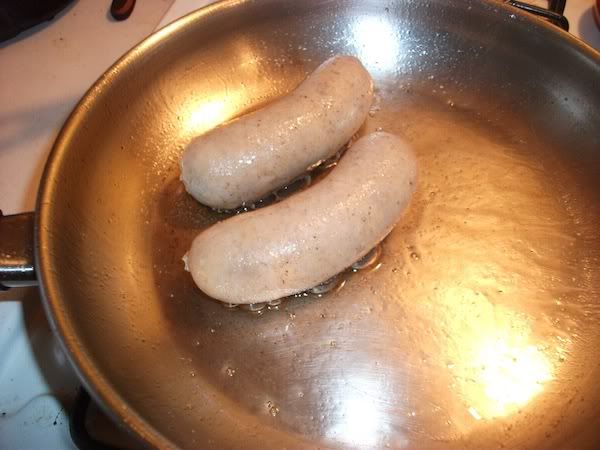
… bratet sie sodann in Butter von beiden Seiten braun…
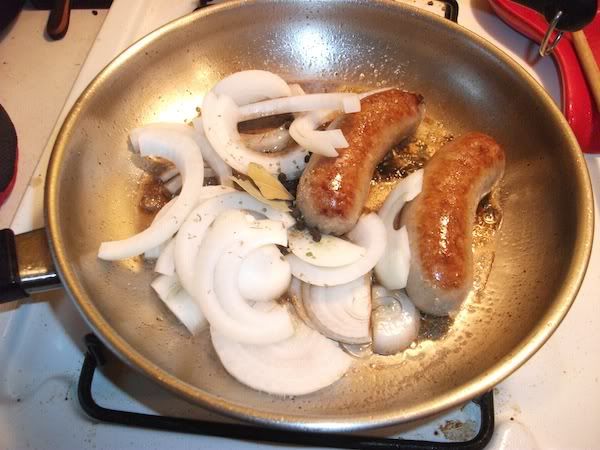
… thut Zwiebelscheiben, Pfefferkörner, ein Lorbeerblatt dazu, gießt ein wenig Weißbier unter, läßt die Wurst rasch kochen, bis das Bier sich auf dem Boden braun angesetzt.

Dann gießt man so viel Weißbier dazu, daß die Wurst bedeckt ist, und läßt sie noch eine Viertelstunde kochen.
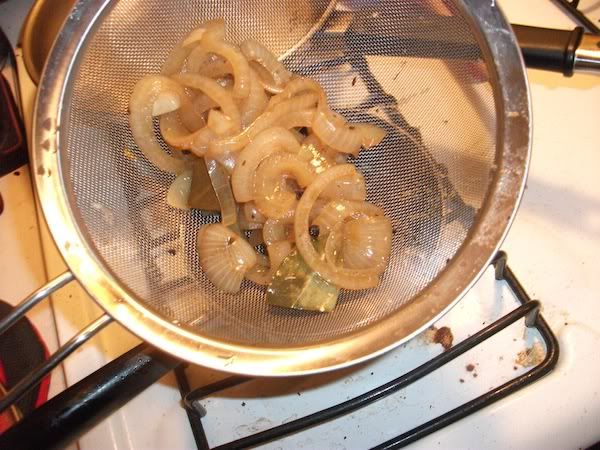
Beim Anrichten nimmt man die Wurst heraus, gießt die Brühe durch ein Sieb…
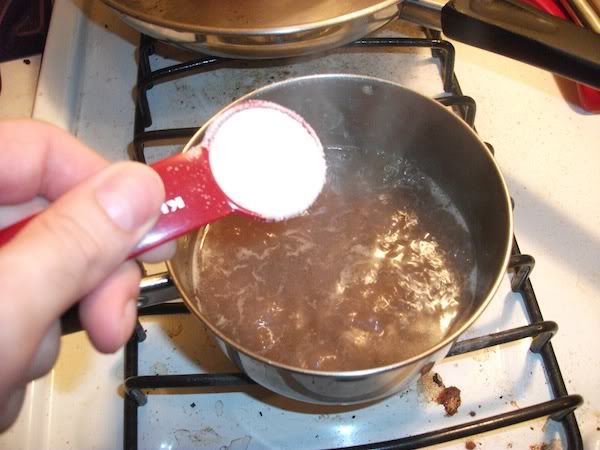
… und kocht sie mit etwas Kartoffelmehl seimig.”
Alright, now that you’re got all that down, it’s on to the next part!
Two days after our sushi night in Köln, the Gastrognome and I found ourselves in the city of Göttingen, home to one of Germany’s most prestigious universities. But we weren’t there for the university, so when it all comes down to it, bringing that up was really quite irrelevant to this story. At any rate, while in Göttingen we met up with our good friend Jonathan, a true world-traveller, scholar and gentleman who is known through all the land for his keen wit, keener intellect and—keenest of all—skill at playing the banjo. Since he hails from the area around Hannover and we had previously only been acquainted with the southern and central portions of Germany, he became an invaluable resource for learning about the strange traditions, customs and practices of this new region in the north. For instance, we learned (among other things) that
Herbert is the sound a frog makes,
“interesting” is the little brother of “shit,” and
it is a common practice in northern Germany for the townsfolk to gather on Sundays and celebrate their day off by burning Catholics at the stake.
And although these and the many other insights we gleaned from Jonathan were of great importance in our quest for cultural understanding, nothing that we learned that day could compare to our introduction to the marvel that is the Lüttje Lage.
Lüttje Lage is a specialty from Hannover, a ritualized drink that I can only assume arose from local boozehounds’ anger over the puny kick provided by their brewskies. Traditionally it consists of a small glass of Schankbier (dark but low in alcohol) and a shot of Korn (a grain alcohol that tastes the way witch hazel smells). The beer glass is held between the thumb and index finger, while the shot glass is pinched between the index finger and the middle finger. Then, as you drink, the Korn pours into the beer before both pour down your throat.
Of course there’s a catch. Aside from the dexterity required to hold both glasses in the same hand and not drop them (most likely resulting in a shirt full of beer and a face full of Korn), you are forced to drink the thing with a certain quickness, lest you dribble all over yourself and become the butt of every joke for the rest of the night. Granted, as anyone who has ever experienced tequila night knows, pounding multiple shots of anything tends to result in dribbling all over yourself in one way or another regardless.
In spite of the potential dangers and pitfalls, we remained undaunted, and seeing as there was special cause for celebration on account of the events post-sushi in Köln, we decided to have at this Hannover specialty. Seeing as we weren’t in Hannover itself, we didn’t have access to the proper Schankbier, but we improvised with a more run-of-the-mill pilsner. How was it, you ask? See for yourself!
 (Anticipation) (Anticipation)
  (Consumption) (Consumption)
 (The prospect of having another) (The prospect of having another)
 (The Gastrognome gives it a go!) (The Gastrognome gives it a go!)
 (Joni takes us both to school) (Joni takes us both to school)
The intrepid Gastrognome and I have a monthly tradition that dictates that on at least one day we must eschew the consuming of lunch in anticipation and preparation for a dinner which involves consuming large (okay, okay–excessive) amounts of sushi and sushi-related food items. But what to do when you’re in a foreign country and the reliable restaurant that you normally frequent is an ocean away? This could have been cause for serious concern a mere score of years ago, but thankfully in this day and age the awesome power of Google is just a click or two of the mouse away, and thus a potential conundrum like this is solved with no more effort than it takes to type “sushi” followed by the name of whatever city you happen to be in and then hitting enter.
So it was that we found ourselves in the city of Köln (Cologne) in Germany in the surprisingly blustery, rainy and definitely not shorts-appropriate month of June. The power of the internet had guided us to a restaurant called Sweet Sushi, selected thanks to the dual virtues of getting good ratings on review sites and being within easy walking distance of our hotel. The place was small but had a friendly look to it in spite of the fact that when we arrived there was not a single table free. We opted to decline a waitress’s offer to seat us at a table with another couple (this is not uncommon in Germany) and chose to simply wait for a few minutes until a table was free. Luckily this did not take much time at all.
Once we were seated, it was on to the ordering! Seeing as we were in Köln, we skipped our traditional Sapporos in favor of Kölsch as the primary beverage of the evening.
(Time for an aside: Kölsch has become a popular summer seasonal for a lot of American craft breweries, but for all the things that US craft beers do right—and there are a lot of them—Kölsch is not among them. I’ve never had a US-born Kölsch that was anything but a pale imitation of Kölsch in Köln.)
Once the drinks were taken care of, it was on to the more interesting matter of selecting fish from the German-language menu, an act that put our knowledge of the names of many sea-creatures to the test. In the end, we opted for a sashimi plate, some nigiri, and a roll with pickled shiitake mushrooms. The food arrived with some sort of additional, complimentary roll that involved shrimp, vegetables, and tempura batter on the outside. It was a nice surprise, but ultimately probably the least interesting thing on the table that night.
And now it’s time to Learn German with Sushi!
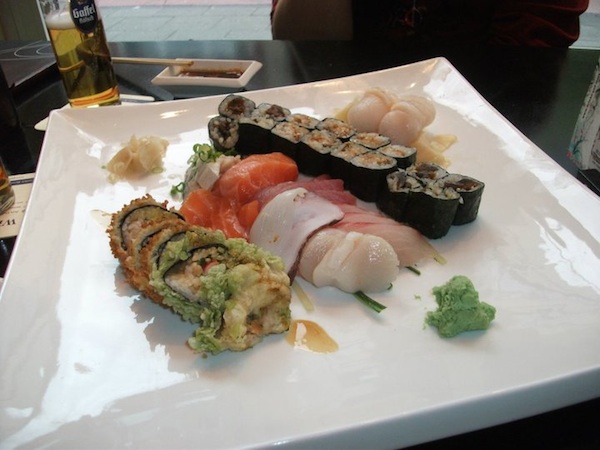 Sie bekommen die Sushis in Bavaria! Ja, in Bavaria, wo die Schafe selten Brille tragen! (from top down, left to right)
die Jakobsmuschel: scallop (nigiri)
der Schiitake-pilz: shiitake mushroom (roll)
das Gemüse: veggies (roll)
der Langflossenthun: albacore (sashimi)
der Lachs: salmon (sashimi)
der Thunfisch: tuna (sashimi)
der Krake: octopus (sashimi)
der Wolfsbarsch: sea bass (sashimi)
der Tintenfisch: squid (sashimi)
das Geschenk des Hauses: on the house (literally the gift of the house)
additionally:
die Sojasoße: soy sauce
der Ingwer: ginger
der Wasabi: wasabi
The food was very good with the exception of the rice that came with the nigiri, which was a bit overly sticky and vinegary. Fortunately that could easily be solved by simply pulling the fish off the top and eating it without the rice. Standouts were definitely the squid which is definitely something that I’m not always a fan of but which was really sweet and tender here, and the pickled shiitake, which had a really unique and pleasing texture on top of just plain being super tasty. It was good enough that we decided to go…
On to Round Two!
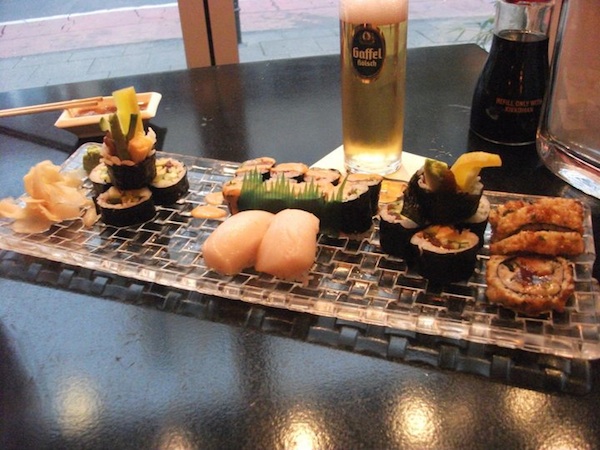 Mahlzeit! Mahlzeit! (left to right across the back)
eine große Rolle: a big roll (this had assorted fish and veggies)
der scharfer Thunfisch: spicy tuna (roll)
noch ein Geschenk: another gift
The last two pieces of nigiri were a bit of a gamble, since we did not actually know what it was that we had ordered until it came out. You see, earlier we had scoured the menu for our beloved white tuna, but hadn’t found anything that seemed to fit that description. That is, until the Gastrognome discovered a promising lead: Butterfisch.
Butterfisch. Butterfisch. What in the world is a Butterfisch? Considering the sushi-restaurant setting, it seemed a safe bet to guess that it would some sort of fish and not some sort of butter. A buttery fish, most likely. And what kinds of fish could be described as buttery? More than that, what kinds of fish could be described as buttery that we hadn’t already been able to identify elsewhere on the menu? White tuna, for sure. Yellowtail—another exceptionally mouth-watering denizen of the deep—could fit the description as well.
We’re not gamblers, but the Gastrognome did grow up in Vegas, and she felt certain that the odds were in our favor. Very well, then: “Dazu noch zwei Butterfisch-nigiri, bitte!”
And the result: Victory! ‘Twas white tuna indeed and it tasted all the more delightful for having come after such a mysterious buildup. The meal was closed with the also delightful surprise of a pair of complimentary glasses of plum wine. (I don’t know why we kept getting free stuff, but it seemed like one of those situations where it was better to just let things keep happening the way they were instead of questioning them.) It was a great dinner full of good food and drink, good company, good atmosphere, happy surprises and it set the stage for the even more wonderful things that would happen later on that night. 😉
PS. 50 Falquan funbucks (that’s right, I’m offering them your money!) to the first one to get the title and caption references.
…is not as good as the sundaes you’ll happen across in Germany. Many food items in Germany are better or different than what you find at home– quark and hazelnut yogurt, to name a couple– but, as Amon and I reconfirmed during our most recent tra-la-la through the Teutonic Tastyland, Germany’s really got it down in the ice cream department.
 Actually, these are pretty run-of-the-mill, by German standards. Old Deutschland definitely does dairy.
As spring leaves us and summer begins (ok, that was a month ago), it’s time yet again that the regional farmers’ markets fire up and appear on street corners and central squares.
Fantastic.
Admittedly, I’d rather they didn’t shut down at 1:00 PM EST here in Cleveland where I live, as most said markets occur on Saturday and I’m not exactly all about getting to sleep early on a Friday night. Thus I wouldn’t call myself ambulatory by any means prior to noon.
That being said, just because it’s a farmers’ market doesn’t mean that you can’t get scammed. Hey, farms are a business too. They’re growing stuff to get people to buy it so they in turn may survive, not (always) out of the goodness of their hearts. They gotta sell the crap along with the Cristal.
In the past, it’s appalled me how few actually know what good ingredients look like, smell like, feel like, and taste like. Everyone should know what their food should these simple sensory inputs. But so few seem to.
Full disclosure: I’m a complete snob here.
I grew up with a father who’s favorite past-time was tending to a garden on the half-acre of land our once rural-burban house was situated on. I grew up on the freshest of vegetables: the bliss of sugar-snap peas and tomatoes still sun-warmed. I liked spinach because I didn’t know what canned or frozen spinach was – we didn’t eat it.
To this day, I love vegetables, based solely on the insanely high quality produce I knew as a kid. Broccoli that tasted sweet, because it hadn’t consumed it’s sugars by way of sitting on a shelf for a month. Bell peppers which resisted, rather than caved at your touch. Brussels sprouts taken from the stalk, just after the first frost which set the sugars properly. Beets. Holy crap the beets. I absolutely love all these things.
Ok, I admit it, I hate zucchini. Not so much I won’t eat it, but, there are better culinary sponges out there.
Anywho.
These are but a modicum of the wonders I grew up with.
Not only were they delicious, they taught me the proper feel, smell, season and flavor of what these products can and should be. Fresh, crisp, sweet. Sublime.
Yet, the more people I meet, the more I find no one knows the basics: an onion should be firm, like a baseball. A peach should smell of…well…peach. Everything, fruits, vegetables; they should feel heavy for their size.
I always thought we all knew these concepts instinctively. Turns out it was just because I knew the best from the get-go – and not the gas station (that’s funny to mid-westerners, just go with me on this).
In the following never-ending series (aaah-aaha-aaha-aaha) that I hope my fellow E-hos embark on with me, is a primer on how to pick proper food: vegetables, meats, fish, dairy, grains and greatness from other food groups (bacon?) yet to be found or that I forgot. This is information we all need to eat, and feed ourselves as a society.
Who knows, you may even find out you like that beet you hated as a kid.
I did.
Ah yes, ramen. Purveyor of absurdly unnecessary levels of sodium to students, cash-strapped persons and suddenly hungry individuals the world over. A delightful little seizure in a styrofoam cup. Surely one cannot live in this world without experiencing it at least one or five thousand times! But as I sat at my desk one day pondering the wonders of tasty food combinations (a frequent occurrence that—for reasons I have not yet been able to determine—seems to arise most often when I am supposed to be working), it struck me: if noodle dishes are better when you make them yourself and soups are better when you make them yourself, then ramen by extension must surely also be better when you make it yourself, no? And so the Gastrognome and I set out on an intrepid quest to a nearby international grocery. Although chef Shouichi Fujimaki may regard ramen as an excellent way to stimulate the economy, we’ve opted for a more budget-minded approach that primarily stars lots of veggies: daikon, shiitake mushrooms, carrots, peas, shallots, scallions and other fun stuff. And then it’s back home for the cooking! The ramen prep does, admittedly, take a touch longer than tearing open a plastic wrapper, boiling water for two minutes and adding a spice packet, but it’s still a fairly simple procedure. Besides, the more time it takes something to cook, the more time you have to drink!
Step 1: Side Dish Detour

To accompany the ramen I made some simple bean sprouts in a chili vinaigrette. The heat and acid make a nice contrast to the salty ramen broth. These are finished quickly and find a spot in the fridge to cool down while everything else gets made.
Step 2: Men Cha

The ramen base. A reduction of soy sauce, sake and water with additional aromatics. It’s the stuff that makes ramen taste like ramen. Quite frankly, it makes pretty much anything taste like ramen. Marinate tofu or meat in it and they’ll quickly adopt that wonderful ramen flavor. Drizzle over rice, rice tastes like ramen. Dunk bread and tomatoes in it, they taste like ramen. Pour it in your friends’ beer… you end the night with a black eye.
Step 3: Noodles
Boil in salted water FTW. No, there’s no picture of noodles boiling in water to accompany this step so get over it already!
Step 4: Broth
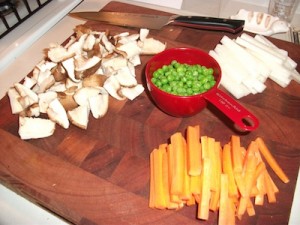 We await the pleasure of being eaten! We made a simple dashi stock and added our veggies. I didn’t boil them too long, since we like them al dente, which I believe is Italian for “old people complain that they’re too hard.”
Step 5: Ramen!
Spoon some men cha into bowls, add noodles, add more men cha, add broth and veggies, stir, garnish. Devour!
 Itadakimasu!
Trust me, I’d rather be “getting in the kitchen” and “making Amon a sammich,” but there’s work to be done. Which means, of course, that I’m daydreaming of making a sammich and reliving the last time I did by posting pictures of it.
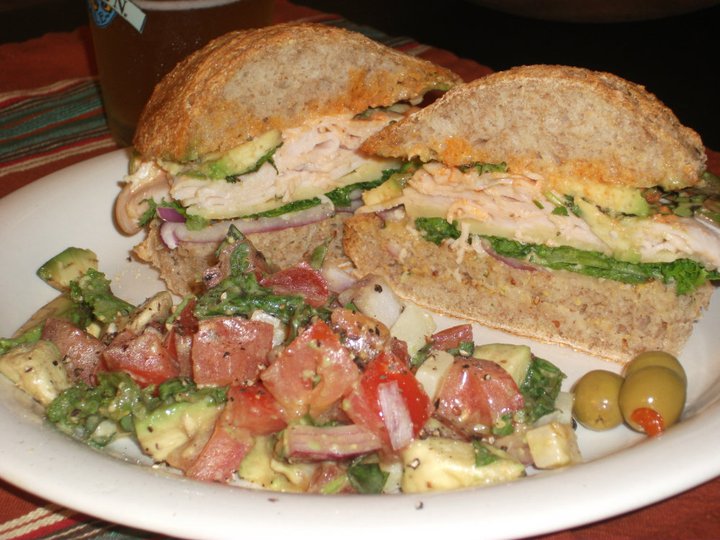 If only all overpriced sandwiches in overpriced restaurants could look and taste this good. Okay, I should elaborate/come clean a bit. I didn’t make this sandwich. Amon’s the god of the sandwich. I did, however, lay the foundation for it, and everyone knows that without a solid foundation, sandwiches are just salads.
I’ll leave the poeticizing to a better writer, so be on the lookout for a sandwich tutorial soon, but for now, I just needed to expound the wonders of home-baked wheat bread, in order that I might have a somewhat more pleasant taste in my mouth before going back to work for the day.
I also promise at some point to do a writeup on The Real Wonder Bread, but for now, you’ll just have to deal with your drool.
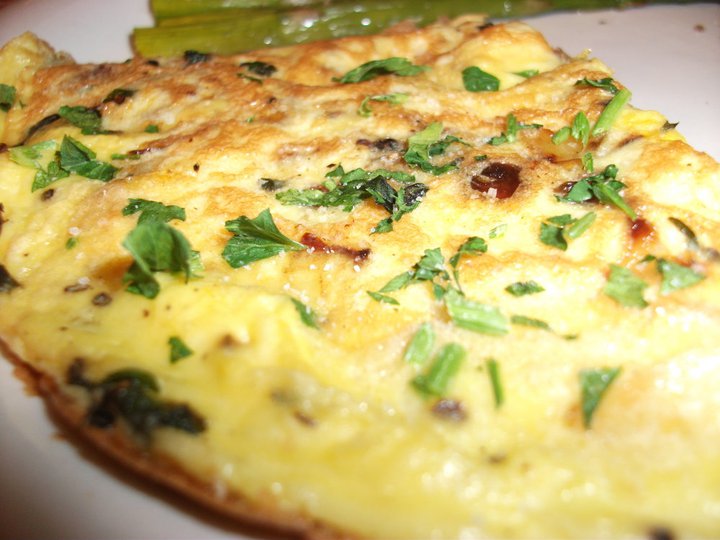 Sometimes, you have to keep it simple.
|
|


















 (Anticipation)
(Anticipation)
 (Consumption)
(Consumption) (The prospect of having another)
(The prospect of having another) (The Gastrognome gives it a go!)
(The Gastrognome gives it a go!) (Joni takes us both to school)
(Joni takes us both to school)








Recent Comments